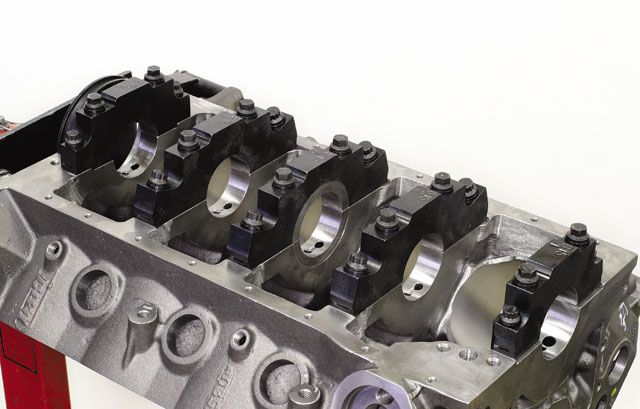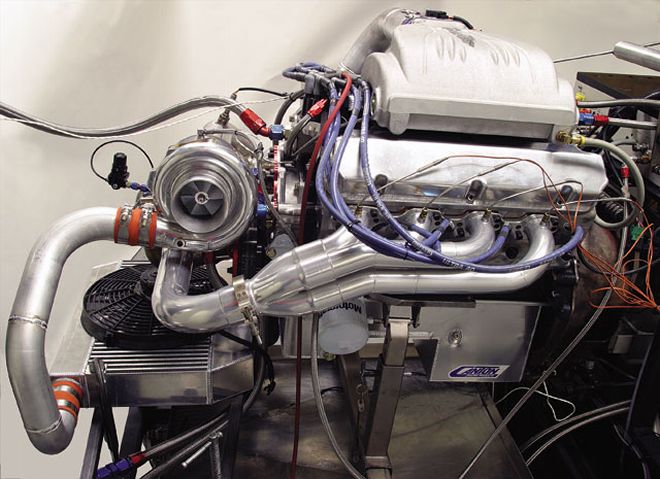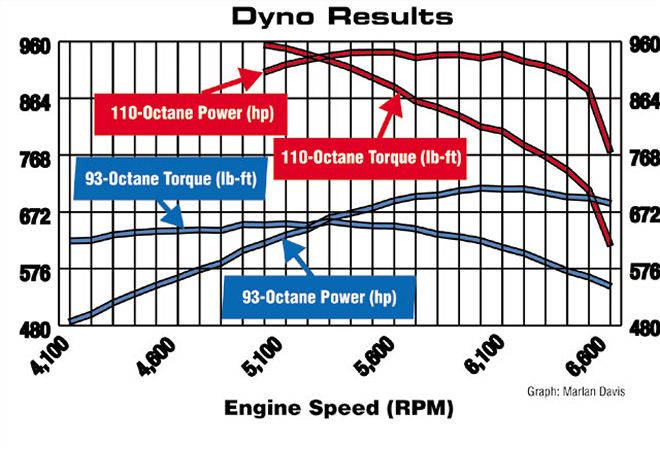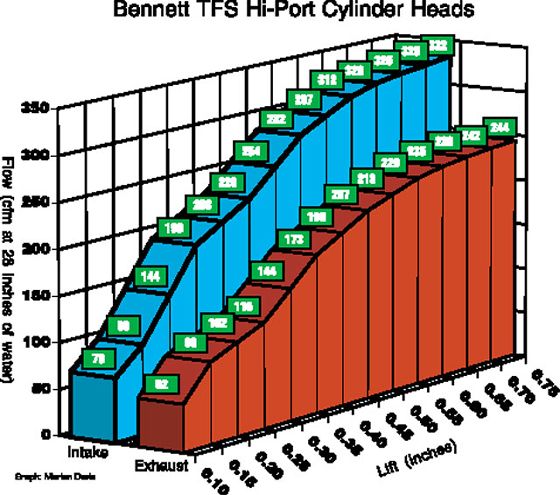
In the last two issues we told you how to select a turbocharger, then we provided some general guidelines on piecing together a complete system. So much for theory. This month we'll get into the real McCoy and examine what goes into an actual street/strip 331ci turbocharged engine built by the pros at Bennett Racing.
Located in northwest Alabama, Bennett is a major builder of kick-butt small-block and big-block Ford drag racing motors. The company is particularly dominant in NMCA and NMRA class racing, supplying normally aspirated, turbocharged, supercharged, and nitrous engines to a variety of winning racers. At Bennett, you can buy anything from cams all the way to turnkey engines developing over 2,000 hp, but the "mild" 900hp engine shown here is designed for street reliability.
 Race on Sunday, drive to work on Monday. On 110-octane race gas with a single T76 turbo and air-to-air intercooler, this Bennett Racing 331ci Ford makes over 900 hp from 5,000-6,400 rpm, and over 900 lb-ft of torque from 5,000-5,400 rpm. Step down to 93 octane and it still makes over 700 hp and 650 lb-ft.
Race on Sunday, drive to work on Monday. On 110-octane race gas with a single T76 turbo and air-to-air intercooler, this Bennett Racing 331ci Ford makes over 900 hp from 5,000-6,400 rpm, and over 900 lb-ft of torque from 5,000-5,400 rpm. Step down to 93 octane and it still makes over 700 hp and 650 lb-ft.
A dual-purpose street/strip engine like this one is among the toughest builds. It's gotta make big power numbers to get down the track and survive in daily use with stock accessories--yet be reasonably affordable. As owner Jon Bennett puts it, "Our goal in building this type of engine is to provide the customer a super-high-horsepower, reliable engine. There are many different opinions on what a true street engine is. Our major concern on a street engine is reliability and low maintenance. We center all of our street engines around hydraulic-roller camshafts. As any experienced engine builder knows, a solid roller is less reliable on the street. Sure, we could put a solid roller profile in this engine and gain some average horsepower, but these gains would be minimal versus the additional maintenance required--valve lash, lifter checks, valvespring wear, and all that."

Dart's thick-wall, four-bolt-main Ford 302 iron block forms the foundation for the engine, which is stuffed with a Scat billet stroker crank, Scat H-beam rods, and premium CP pistons. Cylinder-wall prep is particularly critical, with Bennett making sure to keep the walls straight with minimal taper, and using a 400-grit finish with some cross-hatch to help properly lubricate the piston skirts and aid ring sealing. It's not at all unusual for these engines to have only 0.025 percent leakdown. The block is topped by Bennett CNC-ported Trick Flow Specialties cylinder heads fed by a TFS two-piece EFI intake.
The engine's Turbonetics T76 turbo is more than up to its dual-purpose job, easily supporting 900-1,000 hp. A T76 has a 76mm inducer, which Bennett says "is as big as we can use and still maintain streetability. Even though this engine has a [fairly large] turbo, it still makes boost very quickly due to the cylinder head and camshaft design." Go any larger and you tend to get turbo lag down low, with excessive boost on top. That's obviously not desirable on the street; however, some of the race-only Bennett mills built for the Pro 5.0 classes running Pro Stock-style chassis may go to as large as a 101mm inducer, depending on the weight breaks--but the humongous setup won't clear stock accessories.
 Bennett completely CNC-ports the chambers and the intake and exhaust runners. The exhaust side is specifically designed for a turbo motor, with smaller port dimensions to accommodate different header primary tube sizes and to keep flow velocity up.
Bennett completely CNC-ports the chambers and the intake and exhaust runners. The exhaust side is specifically designed for a turbo motor, with smaller port dimensions to accommodate different header primary tube sizes and to keep flow velocity up.
This recipe definitely has the Wheaties. Young's Performance tested the engine shown here on its SuperFlow dyno. Running on 110-octane race gas, the engine pounded out 941.5 hp at 5,500 and 5,600 rpm, with 954.2 lb-ft of torque at 5,000, where it made 23.3 psi of boost. A well set-up 3,000-pound car, could run mid-8-second e.t.'s at 160 mph with an engine like this. Dropping down to 93-octane unleaded, the motor still churned out 710.8 hp at 6,200 and 655.9 lb-ft at 5,300 on 10.8 psi.
The engine is available as a complete turnkey package--including the turbo, 10x20-inch-core intercooler, 13/4-inch primary-tube headers, and ducting--for $20,000, ready to drop into a '79-'03 Fox-body Mustang. Undressed motors go for $12,000.
If 940 hp from 331 ci ain't enough, there's always the full-race 2,000hp version. Based on the tall-deck Dart 351W aluminum block, the 420ci small-block has bigger heads, stainless headers, and a dry-sump oiling system. Got $50K? HR
Buildsheet
Specifications not listed are the same as stock. Except as noted, all dimensions are in inches or fractions thereof.
Type: Ford Windsor 90-degree OHV V-8
Displacement: 331.6 ci
Bore x Stroke: 4.030 x 3.25
Compression Ratio: 8.24:1
Rod Center-to-Center: 5.40
Rod/Stroke Ratio: 1.66:1
Piston Compression Height: 1.170
Piston Deck Height: 0.010 (below deck)
Piston Volume: -16 cc (dish)
Head-Gasket Bore: 4.100
Head-Gasket Compressed Thickness: 0.054
Combustion-Chamber Volume: 64 cc
Main- & Rod-Bearing Clearance: 0.0027-0.0030
Rod Side Clearance: 0.020-0.025
Crankshaft Thrust: 0.005-0.0055
Piston-to-Bore: 0.0055
Piston-Ring Endgap: 0.025-0.028, top and second
Piston-to-Head (Minimum): 0.040, steel rods; 0.060, aluminum rods
Piston-to-Valve (Minimum): 0.100
Camshaft: Bennett hydraulic roller, 0.570 lift (1.7:1 rockers), 236 degrees at 0.050, 114-degree LDA
Camshaft Thrust (Danny Bee Retainer): 0.004 minimum, 0.006-0.009 preferred
Valvespring (Seat): 140 pounds at 1.850-inch installed height
Valvespring (Open): 400 pounds
Valvespring (Coil-Bind): 1.800
Pushrods: Comp Cams PN 7955-16, 5/16 od x 6.550 OL x 0.080 wall
Spark Plugs: NGK V-Power (R5671A), 0.030 gap
Main-Bearing Bolt Torque (Dart Billet Four-Bolt Caps, ARP Bolts): 65 lb-ft, except outer bolts to 35 lb-ft on cap Nos. 1 and 5
Rod-Bolt Torque (Scat rods, ARP 3/8 bolts): 55 lb-ft
Head-Bolt Torque (ARP 1/2 bolts): 115 lb-ft, top row; 105 lb-ft, bottom row